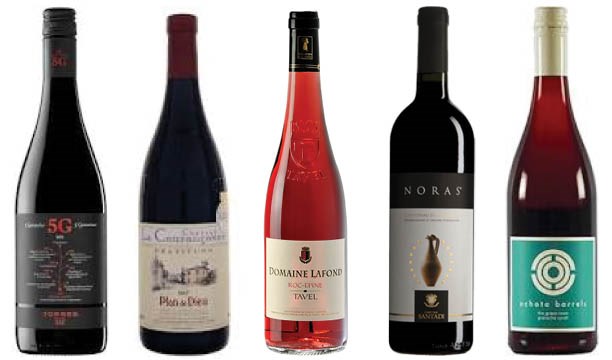As much as I want to toast the sunshine, I’m still in need of a red to warm me up. These days Grenache is deftly serving both purposes. With its warm and generous embrace, Grenache is the quintessential transitional red. It’s equally suited for barbeques as it is for holing up indoors when the rain makes an untimely reappearance.
While it’s one of the world’s most planted grapes, Grenache still flies slightly under the radar. It often hides behind appellation names in countries where the region takes precedence over the grape.
Despite being best known by its French name, Grenache didn’t originate in France. Yet this wine giant does boast the largest amount of Grenache plantings. In particular, it reins king in the area of Languedoc as well as the southern Rhône Valley. Ever had a Côtes-du-Rhône? Then you’ve surely had Grenache.
For long, Spain has confidently laid claim to Grenache’s origins, where it goes by the sassier sounding Garnacha. Prevalent throughout the entire country, it shows up in numerous regions. Navarra, Calatayud, Cariñena and Campo de Borja are just a few to look out for on wine labels.
Most recently the Italians have presented compelling evidence that this grape was born on the island of Sardegna. Here it goes the moniker Cannonau. Don’t worry if you haven’t heard this name before. Not many people have.
Whatever its roots, Grenache clearly loves a Mediterranean climate. Besides basking in the balmy reaches of Southern France, Spain and Italy, it can be found soaking up rays in California, Australia and Chile. And it radiates back that sunshine when it’s in the glass. The result is typically a heady, high alcohol red with rich fleshy fruit and soft tannin. Unabashedly hedonistic, Grenache’s charms come in the form of lush red berries, scented herbs, pepper and sweet spice. Yet as fun-loving as Grenache can be, it does have a more serious side. The regions of Châteauneuf-du-Pape in France and Priorat in Spain offer the most intense, concentrated (and spendy) expressions.
While the debate over birthplace continues, I propose conducting your own research and sampling Grenache in all its guises.
2013 Torres, ‘5G’ Campo de Borja DO, Spain $15.99
Mmmm Garnacha… Very pure red fruit nose with baked sweet thyme and pepper. It simply drips with succulent raspberry and crunchy red plum. Alcohol is kept beautifully in check. This is the ultimate barbeque wine.
2012 Château la Courançonne, ‘Gratitude’ Plan de Dieu Côtes-du-Rhône Villages AOC, France $20.89
Grenache with a healthy dose of Syrah. Black cherry, black plum, dried herbs and chewy tannin provide a satisfying mouthful that would stand up to a lamb roast.
2013 Domaine Lafond, ‘Roc-Epine’ Tavel AOC, France $21.79
Grenache is also a much-loved grape for making rosé. A staple on our shelves, this dry example allows us to drink pink year round. Strawberry, cherry and bitter orange peel. Bigger boned and a bit boozy but perfect for grilled chicken.
2011 Santadi, ‘Noras’ Cannonau di Sardegna DOC, Italy $30.49
Intriguingly earthy tobacco, leather and coffee aromas with hints of black licorice. Dense rich fruit reminiscent of plum cake and a clove spice finish. Made for roasted suckling pig.
2012 Ochota Barrels, ‘The Green Room’ Grenache Shiraz, McLaren Vale, Australia $32.19
Super fragrant and fresh. Fruit driven but in a just-picked bowl of summer berries way. Light on its feet and nothing jammy about this. Just quaff.
All available at BC Liquor Stores. Prices are exclusive of taxes.




